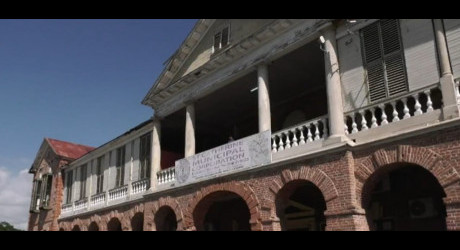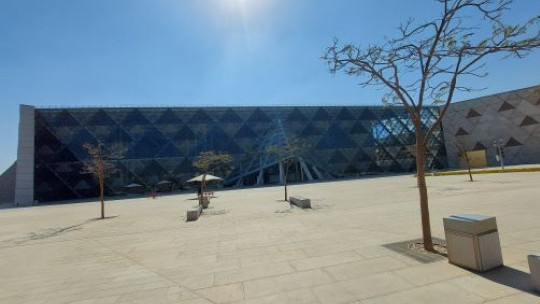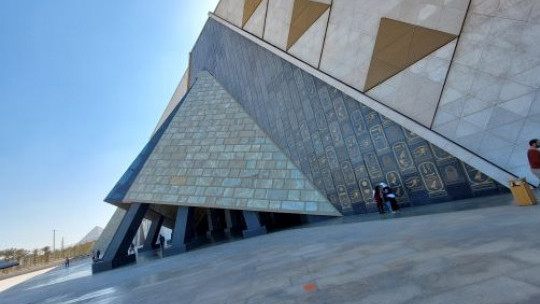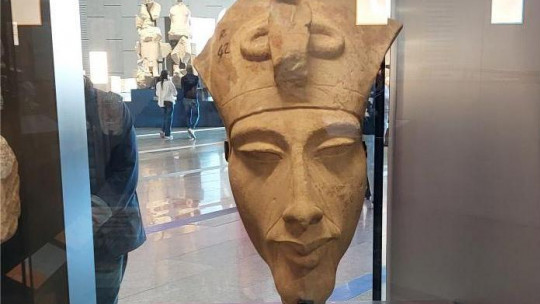Mixed with Vain Imagination
11:32 am, Fri March 28, 2025
By Bumpy Walker
All Egyptian artifacts must be returned to Egypt!
This is the single inescapable conclusion that any visitor can have after seeing the yet to be officially opened Grand Egyptian Museum (GEM). Superlative adjectives will fail to capture the magnificent, grandeur, location, architecture, skill, layout, educational impact after any visit to this the largest museum in the world.
As previously mentioned, in the last decade there has been significant investment in Egypt’s infrastructure. Highways are being built, monorails are being constructed, and the Suez Canal has been expanded. In addition, a new Library of Alexandria has been opened, salving the pain of those who still mourn the original library’s destruction. For a history buff, the Grand Egyptian Museum has to be the pinnacle investment. It not only shows that there is an eye to the future but the importance that has been placed on acknowledging the past. This is not simply a vanity or a politically expedient project, there are cold hard reasons for it. A revenue multiplier, a driver for education and research. It will encourage Egyptians to study and research the past, but also it has a direct impact in STEM as new techniques have to be developed to preserve and engineer the study of archeology.
Setting
All museum settings pale into insignificance in comparison. GEM is sited in line of sight of the pyramids of Giza. Outside is a sweeping space with a restrained water feature. The building has an angled facade reminiscent of the pyramids, decorated in hieroglyphs. The pinnacle for me is the floating oblelisk / stelae. Entering the museum: This is a cathedral to the past, a vast sweeping vestibule large enough to dwarf the statues that are on display.
To enter the museum one is drawn, organically led up a large stairway with strategically placed statuary, columns and sarcophagi to the fifth floor and to the entrance to the displays. For us at the veteran stage there is a moving walkway that delivers our bodies without loss of breath to the top, while blowing our minds! At the top, a large window frames the pyramids of Khafre and Khrufu on the Giza plateau.
To the left of the window is the entrance to the heart of the museum, in which is arranged in sequence the narrative of Egypt. Forget the idea of dank, creaky, obscure dusty, Victoriana and Edwardian displays of faded dioramas. This is a large, airy, well lit, high roofed, climate controlled, non-squeaky, marble-floored, interconnected space that guides through prehistory, predynastic, unified Upper and Lower Egypt. Lifelong family learning at its best. After the first hall it is overwhelming. Well, I was overwhelmed. So, I sat for a beat.
You have the Wrong Interpretation
Fortunately, my insomniac friend in Jamaica was still awake, who by this time I had overloaded with pictures of ancient carved stone, bone, metal detritus of memories without supporting context. Sitting for a moment contemplating the emotion. I received this consolatory message, “This must make Americans and Europeans feel culturally small” triggering the Bob Marley lines “ You have the wrong interpretation, mixed with vain imagination. For the rest of my time in the GEM, Bob’s Confrontation album music accompanied me mentally.
Throughout the museum there are Egyptian guides explaining to different tour groups the displays in Mandarin, Russian, Italian, English and Arabic. As a test I listened to a Spanish speaking tour guide for a brief moment. It was a delight to see my rusty, underutilized Spanish is still functional! This demonstrates the need, the value of art-focused education being as necessary as STEM in nation building.
This is a modern museum, there are multimedia displays, two of which are memorable. The first shows the conquest of Egypt by foreign interlocutors. These included the Libyans, the Nubians, the Assyrians, the Persians, Greek, the Romans who in turn and time were culturally overwhelmed by the power of this Northeast African culture. It's not like the Egyptians were pacifist. They went “a Vikinging” to Palestine, Libya, Nubia. Yes, Ramses the Great got his claim to greatness by claiming success at war. Like the Vikings, they were the consummate traders, who traded Lapis Lazuli (examples of which are on display) in the Early Dynastic period from far Afghanistan.
The other was an imaginative display which took the art on the wall of a Pharaoh's tomb, enhanced the image then turned them into a stop motion film. The museum currently ends with the display of the Romano period.
Valentine’s Day
My visit took place on Valentines Day; thus, the display that resonated serendipitously was a painted wall display of a high government official, Infer holding hands with his wife surveying their family. For a feminist perspective, both figures are the same height. But a display announced that women in pharaonic art of that period were painted white.
Exiting, the concept of modern commerce is not forgotten. With a well lit modern food hall, there’s a bookstore in a broad internal avenue. Then at the end facing the exit is a grand red granite statue of Rameses II - “Ozymandias”. My reaction to this broken statuary was joy; triumph does not despair as described in Percy Shelly’s great and oft quoted poem “Ozymandias”. You have the wrong interpretation, indeed!
Echoes of Ukraine
That despair is the reaction of a colonialist trope at the triumph over the history of the power, elegance of those they, the colonialists, saw as less than. It was in this era, which the Chinese now describe as “the era of humiliation” that the French, British, Germans, appropriated the treasures of Egypt as trophies of triumph to their expansionist experiment.
These trophies are now displayed in dusty museums in Berlin, London and Paris. Whenever discussions come up about the return of these artifacts, the argument is used that they are held for the benefit of mankind; further, that Egypt lacks the skills or wherewithal to successfully preserve, study or display. The GEM proves otherwise. The Rosetta Stone, the missing Tutankhamen treasures, and Nefertari head should be repatriated. Ah the argument will be raised that these were acquired by fair treaty! Again, the Chinese have a description of the century in which many of these treaties were signed. The century of unfair treaties!
Bumpy Walker, a history addict, is overdosing on Egypt!

7:56 pm, Mon December 1, 2025

12:18 am, Sat November 29, 2025

3:07 pm, Wed December 3, 2025










 All feeds
All feeds







